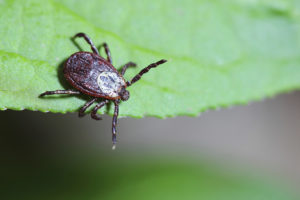
They lie in wait in the tall grass, hoping to hop onto unsuspecting passersby.
They’re just teeny-tiny ticks, but these dark-bodied bloodsuckers can pack a powerful—and potentially serious—punch.
And this year, the ticks are out in full force, experts say. The season is expected to be an especially bad one for ticks, because of an overall warming trend and more people getting outside during the pandemic.
“Many of us have heard about the tick boom,” said Rosemary Olivero, MD, a pediatric infectious disease specialist with the Spectrum Health Medical Group, in an interview a few years ago. “It’s important to remember that we always expect a dramatic increase in the presence of all types of ticks during this time of year.”
The Michigan Department of Community Health has reported an increase in black-legged ticks along the Lake Michigan shorelines during the past several years. The black-legged tick was formerly referred to as the deer tick.
Brian Hartl, an epidemiologist at the Kent County Health Department’s Communicable Diseases division, said the tick boom has been a multi-year trend. His counsel is the same now as it was years ago.
“In terms of ticks, we don’t do any surveillance, per se, but we know the tick habitats are spreading eastward,” Hartl explained. “Historically, black-legged ticks—those that carry Lyme disease—have been on the lake shore. But they’re expanding inland from the lakes.”
But there’s more trouble to ticks than just Lyme disease, Dr. Olivero said.
“The black-legged tick can transmit Lyme disease, which is the most common tick-borne infection in Michigan,” she said. “The same tick can also transmit Anaplasmosis and Babesiosis, which almost never occur in Michigan. Other ticks (such as the American Dog tick, Lone Star tick, Woodchuck tick and Brown Dog tick) can transmit other diseases: Rocky Mountain spotted fever, Tularemia, Ehrlichisos, Anaplasmosis and Babesiosis. Luckily these infections are quite rare in Michigan.”
Two years ago, the Centers for Disease Control and Prevention issued a warning about a general uptick in all insect-borne illness.
This arrived on the tails of the agency sharing news about a new, formerly rare tick-borne illness—the Powassan virus. Powassan cases are expected go up as the ranks of mice and the ticks that carry the disease increase.
Symptoms of this serious infection can include fever, headache, vomiting, weakness, confusion, seizures and memory loss. Long-term neurologic problems may occur. The CDC notes there is no specific treatment, but some people need to be hospitalized to receive respiratory support and intravenous fluids or medications to reduce swelling in the brain.
Hartl said the best defense against ticks is to make it tough for them to latch on in the first place.
“Really it’s just being cognizant of your environment,” he said. “If you’re camping or hiking, wear pants or long socks to keep from getting ticks. They like to hang out in long grass and grab hold of you as you walk by.”
And if you do find a tick attached to your body, properly remove it. There are some videos online for how to do so. Dr. Olivero recommended this video for the proper way to remove ticks. For Lyme disease to be transmitted, ticks need to be attached for 24 to 48 hours.
“If you can remove it quickly enough you can keep from getting Lyme disease,” Hartl said.
Dr. Olivero agreed.
“There are two effective ways to prevent tick bites: wearing long sleeves, and using insect repellents,” she said. “Doing daily tick checks to remove any attached ticks can help prevent contracting Lyme disease from a tick. Important areas to check for ticks include the hairline and behind the ears. Carefully, using pointed tweezers, is the most effective way to remove a tick.”
 /a>
/a>
 /a>
/a>
 /a>
/a>
When animal habitats are chopped up into tiny disconnected pieces by spreading home developments diseases like tick-borne Lyme, Ehrlichiosos, etc. are more easily carried into the community. Like avoiding plastics and glyphosate, this is another case where prevention is much easier, healthier and so much less costly.
I am soooo horrified of this epidemic tic dilemma and love the woods, state parks, etc. Because we live on Lake Michigan and have the most beautiful inland lakes surrounding us here in Ludington we just need to be more aware of exposure to tics and do thorough checks each and every time we venture out!
So glad you don’t let the ticks keep you inside! It’s so beautiful out. We enjoy the great outdoors, but take precautions (permethrin on clothes; DEET spray) and do tick checks frequently. We also seek to avoid high grass or areas with lots of shrubbery; stick to the middle of the trail.
I had a deer tick latch on to the back of my thigh in Oct 2013 at Lake Michigan – and I was wearing jeans. I felt pain but couldn’t see it until I got a hand mirror & saw the legs moving under my skin. Since I couldn’t get it out myself, I went to Urgent Care where they safely removed it & put me on antibiotics to prevent Lyme Disease. Glad I didn’t ignore the annoying pain.
5 min in my backyard. No tall grass or shrubbery, ended up with a tick on my back. Well before he had the chance to burrow in.
The tick in the lead photo is a female American dog tick (Dermacenter variabilis). It’s useful to know the difference.
The black-legged tick or deer tick (Ixodes scapularis) looks like this:
https://tickencounter.org/tick_identification/deer_tick